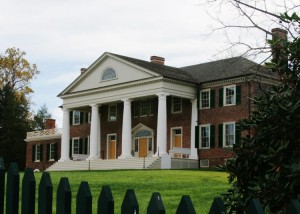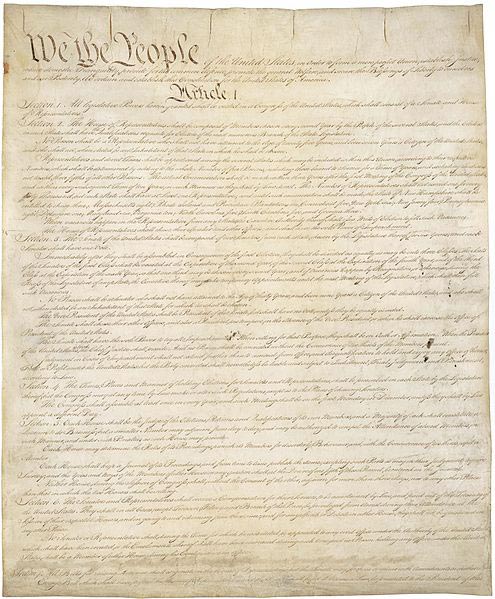| James Madison | |
|---|---|
 |
|
| 4th United States President « Previous Next » |
|
| In office | Mar. 4, 1809 – Mar. 4, 1817 |
| V. President | George Clinton |
| Elbridge Gerry | |
| Political Party | Democratic-Republican |
| Personal Info | |
| Born | Mar. 16, 1751 |
| Died | June 28, 1836 (at age 85) |
| School | Princeton |
| Profession | Planter |
| Signature | |
| Wife | Dolley Todd |
| Children | John Payne Todd (stepson) |
| U.S. Presidents 1-15 | |
| 1. George Washington (1789–1797) | |
| 2. John Adams (1797-1801) | |
| 3. Thomas Jefferson (1801-1809) | |
| 4. James Madison (1809-1817) | |
| 5. James Monroe (1817-1825) | |
| 6. John Quincy Adams (1825-1829) | |
| 7. Andrew Jackson (1829-1837) | |
| 8. Martin Van Buren (1837-1841) | |
| 9. William Henry Harrison (1841-1841) | |
| 10. John Tyler (1841-1845) | |
| 11. James Knox Polk (1845-1849) | |
| 12. Zachary Taylor (1849-1850) | |
| 13. Millard Fillmore (1850-1853) | |
| 14. Franklin Pierce (1853-1857) | |
| 15. James Buchanan (1857-1861) | |
| List of All the Presidents |
The United States Constitution and the United States Bill of Rights are two of the most important documents in American history. They are also two of the most important contributions of the fourth president of the United States, James Madison.
The contributions of James Madison have carved such a significant impact on the lives of Americans that it lasted and persisted through the years, from his time as a politician up to the present. A quick review of the life and contributions of the “Father of the Constitution” would not be enough to encapsulate this impact, but it is still essential in understanding a big part of history.
James Madison’s Early Life
James “Jemmy” Madison, Jr. was the son of James Madison, Sr., a tobacco planter, and Nelly Conway Madison, a daughter of a tobacco merchant. Not surprisingly, Jemmy, eldest of twelve siblings, was born in the Belle Grove Plantation, located Port Conway, Virginia, on March 16, 1751.
Young Jemmy became a student of the Scottish teacher Donald Robertson, who, at that time, was teaching in Virginia. Robertson gave his student a foundation on geography, mathematics, and the languages, and so the young Madison credited him as the reason for his love of learning.
When Madison was 16, his studies shifted to a two-year tutorial under Reverend Thomas Martin, as a preparatory course before the young man would go to college. By the time that Madison was to choose where to attend college, he had notably fragile health. Thus, he picked a school located at an area of good climate, and this school was the College of New Jersey – or, as we know it now, Princeton University.
In spite of his health condition, Jemmy Madison graduated from Princeton in 1771, and even stayed there to learn Hebrew and political philosophy. He also studied law, but instead of using it for a career, he focused on public policy.
 Not long after, when he had already become a member of the Congress, he met Dolly Payne Todd, a widowed woman who had a son, John Payne Todd. James and Dolly married on September 15, 1794, and James adopted Dolly’s son John.
Not long after, when he had already become a member of the Congress, he met Dolly Payne Todd, a widowed woman who had a son, John Payne Todd. James and Dolly married on September 15, 1794, and James adopted Dolly’s son John.
It is amusing to note that Dolly had a sister, Lucy, who married George Washington’s nephew, George Steptoe Washington.
Early Political Career
It has been noted that Madison was fond of public policy. He had a soft spot for the concept of religious freedom. This was clearly exhibited when he worked on such cases as those of the Baptist preachers. The preachers had been arrested because they were preaching with no license from the Anglican Church.
Madison became part of the Virginia state legislature from 1776-1779. During this time, he met Thomas Jefferson and eventually came to learn the ropes under his wing.
It was also during this period when Madison truly started his work as a politician. He initiated and took part in major changes in Virginia, such as the drafting of the Virginia Statute for Religious Freedom, the formation of the Episcopal Diocese of Virginia, and the giving up of Virginia’s claims over several disputed northwestern territories.
Because of his active role in politics, many saw James Madison as a hardworking man, and thus, he was once again elected to be part of the Virginia House of Delegates in 1784-1786.
Father of the Constitution
 During the early period of Madison’s time, a common concept of citizen rights and power was that they were granted to the people by the government. There was no document to uphold this. In fact, even the then-13 states of America were held together only by the Articles of Confederation, which was considered as basically a military alliance between those states.
During the early period of Madison’s time, a common concept of citizen rights and power was that they were granted to the people by the government. There was no document to uphold this. In fact, even the then-13 states of America were held together only by the Articles of Confederation, which was considered as basically a military alliance between those states.
Without a more solid and thorough document, there was much concern over national welfare, with looming issues like union break-up and bankruptcy. Madison was one of the leaders who were openly troubled by these issues.
Thus, James Madison worked hard to help call a national convention in 1787, where he presented a thorough plan for solutions, known as the Virginia plan. A major part of the plan was to divide the governmental power into the federal and state governments. The Virginia plan soon became the basis of the US Constitution.
Madison impressed the attendees of the Constitutional Convention, but he did not stop there. He pushed for the ratification of the Constitution. Ratification required that every US state decided on whether or not to adopt the document as the Constitution.
To further the cause, Madison enlisted the help of John Hamilton and John Jay to write the Federalist Papers, a collection of 85 writings from newspapers that helped explain the Constitution to the people. The book was published in all 13 states, and it also became a handbook for supporters.
Madison also had to undergo some other struggles, notably the debate in Virginia, the state with the biggest population, crucial in the ratification. He emerged victorious from this debate, and Virginia gave its conditional ratification.
Because of his great work in the Constitution, Madison earned the title “Father of the Constitution”.
Historians add that Madison remained modest in spite of this name. He did not want sole credit for the Constitution because, as he said, it was “the work of many heads and many hands”.
Writing the Bill of Rights
James Madison’s other great contribution to America could be considered an offshoot of the road towards the Constitution, albeit an excellent one. This is the Bill of Rights, and it was born out of a condition.
In the debate over the Constitution, anti-Federalists would support the ratification only if there was a bill of rights. Madison objected at first, saying that a bill of rights was unnecessary and could only cause dangerous misinterpretations. However, he eventually yielded to the demands.
Out of over 200 amendments submitted by people, the then-Congressman Madison made a synthesis of 12 amendments and collected these into a proposal. Several more amendments were made, until, in 1791, the Bill of Rights was ratified.
Madison’s Presidency
 In 1801, James Madison became the US Secretary of State, under the presidency of Thomas Jefferson. He eventually became a presidential candidate, as chosen by his party in their Congressional Caucus. And in 1808, he defeated his opponent Charles Cotesworth Pinckney and won the national elections.
In 1801, James Madison became the US Secretary of State, under the presidency of Thomas Jefferson. He eventually became a presidential candidate, as chosen by his party in their Congressional Caucus. And in 1808, he defeated his opponent Charles Cotesworth Pinckney and won the national elections.
As with his early political life, Madison’s presidency was rich in highly significant events.
In 1815, he signed a Congressional legislation chartering the Second Bank of the United States, the national bank of the country. He was initially hesitant to do so, but the charter of the first bank had expired, and the Treasury had found it difficult to deal with war without the bank, so Madison agreed to create the second one.
It was also during Madison’s presidency when Britain launched several acts of insult towards America. Eventually, the US President declared war, and this was the War of 1812.
The British forces, however, were strong and they attained many victories. At one point, the British were closing in on the White House. James was out with the troops, so his wife Dolly had to play the important role of transporting White House valuables to safety. The valuables that she had saved, which included George Washington’s portrait, are reportedly only ones left of the original White House – the British destroyed all the rest.
In spite of many obstacles, however, America had an impressive strength, particularly in its naval fleets. Little by little, they claimed victories over their opponents. Finally, in 1815, the war ended with the Treaty of Ghent. Neither parties of the war gained new territories, but many historians agree that Americans view the War of 1812 to be the second greatest war that ensured their independence.
The President’s Legacy
James Madison’s historic presidency ended with his retirement in 1817, when he was 65 years old. He spent his days at his Virginian tobacco plantation. He also became Rector of the University of Virginia, and even served once again as a representative to the 1829 constitutional convention of Virginia. His health was waning, but he remained true to his service until he passed away on June 28, 1836.
Having been such a significant persona in America, James Madison left a legacy that the country will not forget. Dozens of landmarks, towns, cities, institutions, and natural resources have been named after him. His portrait was also featured in the US $5,000 bill.
But the true legacy of James Madison was the change of the course of history that millions are now benefiting from. As one of the Founding Fathers, he was part of the birth of America as a nation. As the Father of Constitution, he ensured that this nation would become whole, united, and most of all, in the hands of the people. And as a huge force behind the Bill of Rights, he empowered and inspired the people.
James Madison’s legacy is not contained in the United States – they rippled throughout the world. With that, he was indeed a great President.